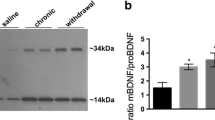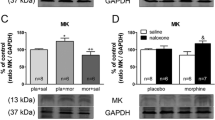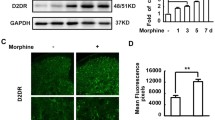Summary
The effect of morphine and naloxone on release of the excitatory amino acids (EAAs) of spinal astrocytes induced by TNF-α was studied. Astrocytes were purified from 2- to 3-day old SD rats and divided into 8 groups: group 1 (without any stimulatants); group 2 (10 ng/ml TNF-α); group3 (10 ng/ml TNF-α+0.5 μmol/L morphine); group 4 (10 ng/ml TNF-α+1.0 μmol/L morphine); group 5 (10 ng/ml TNF-α+2.0 μmol/L morphine); group 6 (10 ng/ml TNF-α+0.5 μmol/L naloxone); group 7 (10 ng/ml TNF-α+1.0 μmol/L naloxone); group 8 (10 ng/ml TNF-α +2.0 μmol/L naloxone). In group 2, 3, 4 and 5, 0, 0.5, 1.0 or 2.0 μmol/L morphine was added to the cells cultured with serum-free Neurobasal/B27 medium containing 10 ng/ml TNF-α respectively, while in group 6, 7 and 8, 0.5, 1.0 or 2.0 μmol/L naloxone was added respectively to the cells cultured with serum-free Neurobasal/B27 medium containing 10 ng/ml TNF-α. After 30 min incubation, high-pressure liquid chromatography (HPLC) was used to measure the levels of EAAs in all cultured cells. The results showed the level of EAAs in group 2 was significant higher than in group 1 (P<0.01). As compared with group 2, the levels of EAAs in group 3, 4 and 5 were decreased with the difference being significant between group 5 and group 2 (P<0.01) or between group 4 and group 2 (P<0.05). The levels of EAAs in group 6, 7 and group 8 was significantly lower than in group 2 (P<0.05 orP<0.01). It was concluded that TNF-α could promote the release of glutamate and aspartate from astrocytes, and morphine and naloxone might reduce the release of EAAs in cultured spinal astrocytes induced by TNF-α.
Similar content being viewed by others
References
Watkins L R, Milligan E D, Maier S F. Glial activation: a driving force for pathological pain. Trends Neurosci, 2001,24:450
Zhao Z F, Liu Q Y, Zhu C G. Excitative effect of TNF-α-activated astrocytic conditioned medium on hippocapal neurons. Chin J Anat (Chinese), 2002,25(3):205
McCarthy K D, Devellis J. Preparation of separate astroglial and oligodendroglial cultures from rat cerebral tissue. J Cell Biol, 1980,85(3):890
Watkins L R, Milligan E D, Maier S F. Spinal cord glial: new players in pain. Pain, 2001,93:201
Bianchi L, Colivicchi M A, Bolam J Pet al. The release of amino acids from rat neostriatum and substantia nigra in vivo: a dual microdialysis probe analysis. Neuroscience, 1998,87(1):171
Hopkins S J, Rothwell N J. Cytokines and the nervous system. I: Expression and recognition. Trends Neurosci, 1995,18(2):83
Diehl J A, Tong W, Sun Get al. Tumor necrosis factor-alpha-dependent activation of a RelA homodimer in astrocytes. Increased phosphorylation of RelA and MAD-3 precede activation of RelA. J Biol Chem, 1995, 270(6):2703
Author information
Authors and Affiliations
Additional information
Xiang Hongbing, male, born in 1969, M. D., Ph. D.
Rights and permissions
About this article
Cite this article
Hongbing, X., Yuke, T. & Yi, S. Effect of morphine and naloxone on release of the excitatory amino acids of spinal astrocytes induced by TNF-α. Current Medical Science 25, 91–93 (2005). https://doi.org/10.1007/BF02831397
Received:
Published:
Issue Date:
DOI: https://doi.org/10.1007/BF02831397




